Weiwei Zhang
Rethinking Schema Linking: A Context-Aware Bidirectional Retrieval Approach for Text-to-SQL
Oct 16, 2025Abstract:Schema linking -- the process of aligning natural language questions with database schema elements -- is a critical yet underexplored component of Text-to-SQL systems. While recent methods have focused primarily on improving SQL generation, they often neglect the retrieval of relevant schema elements, which can lead to hallucinations and execution failures. In this work, we propose a context-aware bidirectional schema retrieval framework that treats schema linking as a standalone problem. Our approach combines two complementary strategies: table-first retrieval followed by column selection, and column-first retrieval followed by table selection. It is further augmented with techniques such as question decomposition, keyword extraction, and keyphrase extraction. Through comprehensive evaluations on challenging benchmarks such as BIRD and Spider, we demonstrate that our method significantly improves schema recall while reducing false positives. Moreover, SQL generation using our retrieved schema consistently outperforms full-schema baselines and closely approaches oracle performance, all without requiring query refinement. Notably, our method narrows the performance gap between full and perfect schema settings by 50\%. Our findings highlight schema linking as a powerful lever for enhancing Text-to-SQL accuracy and efficiency.
Do LLMs Align with My Task? Evaluating Text-to-SQL via Dataset Alignment
Oct 06, 2025

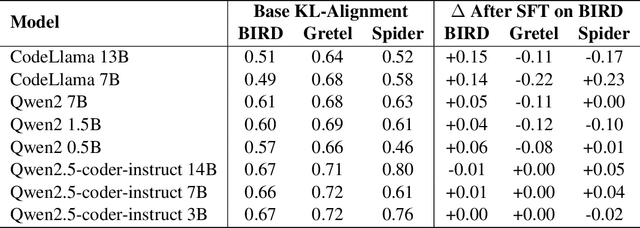

Abstract:Supervised Fine-Tuning (SFT) is an effective method for adapting Large Language Models (LLMs) on downstream tasks. However, variability in training data can hinder a model's ability to generalize across domains. This paper studies the problem of dataset alignment for Natural Language to SQL (NL2SQL or text to SQL), examining how well SFT training data matches the structural characteristics of target queries and how this alignment impacts model performance. We hypothesize that alignment can be accurately estimated by comparing the distributions of structural SQL features across the training set, target data, and the model's predictions prior to SFT. Through comprehensive experiments on three large cross-domain NL2SQL benchmarks and multiple model families, we show that structural alignment is a strong predictor of fine-tuning success. When alignment is high, SFT yields substantial gains in accuracy and SQL generation quality; when alignment is low, improvements are marginal or absent. These findings highlight the importance of alignment-aware data selection for effective fine-tuning and generalization in NL2SQL tasks.
TaoCache: Structure-Maintained Video Generation Acceleration
Aug 12, 2025Abstract:Existing cache-based acceleration methods for video diffusion models primarily skip early or mid denoising steps, which often leads to structural discrepancies relative to full-timestep generation and can hinder instruction following and character consistency. We present TaoCache, a training-free, plug-and-play caching strategy that, instead of residual-based caching, adopts a fixed-point perspective to predict the model's noise output and is specifically effective in late denoising stages. By calibrating cosine similarities and norm ratios of consecutive noise deltas, TaoCache preserves high-resolution structure while enabling aggressive skipping. The approach is orthogonal to complementary accelerations such as Pyramid Attention Broadcast (PAB) and TeaCache, and it integrates seamlessly into DiT-based frameworks. Across Latte-1, OpenSora-Plan v110, and Wan2.1, TaoCache attains substantially higher visual quality (LPIPS, SSIM, PSNR) than prior caching methods under the same speedups.
Continuous Self-Improvement of Large Language Models by Test-time Training with Verifier-Driven Sample Selection
May 26, 2025Abstract:Learning to adapt pretrained language models to unlabeled, out-of-distribution data is a critical challenge, as models often falter on structurally novel reasoning tasks even while excelling within their training distribution. We introduce a new framework called VDS-TTT - Verifier-Driven Sample Selection for Test-Time Training to efficiently address this. We use a learned verifier to score a pool of generated responses and select only from high ranking pseudo-labeled examples for fine-tuned adaptation. Specifically, for each input query our LLM generates N candidate answers; the verifier assigns a reliability score to each, and the response with the highest confidence and above a fixed threshold is paired with its query for test-time training. We fine-tune only low-rank LoRA adapter parameters, ensuring adaptation efficiency and fast convergence. Our proposed self-supervised framework is the first to synthesize verifier driven test-time training data for continuous self-improvement of the model. Experiments across three diverse benchmarks and three state-of-the-art LLMs demonstrate that VDS-TTT yields up to a 32.29% relative improvement over the base model and a 6.66% gain compared to verifier-based methods without test-time training, highlighting its effectiveness and efficiency for on-the-fly large language model adaptation.
Balancing Computation Load and Representation Expressivity in Parallel Hybrid Neural Networks
May 26, 2025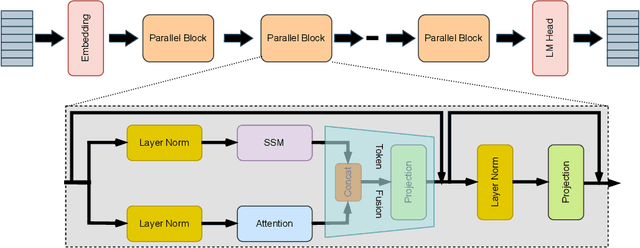
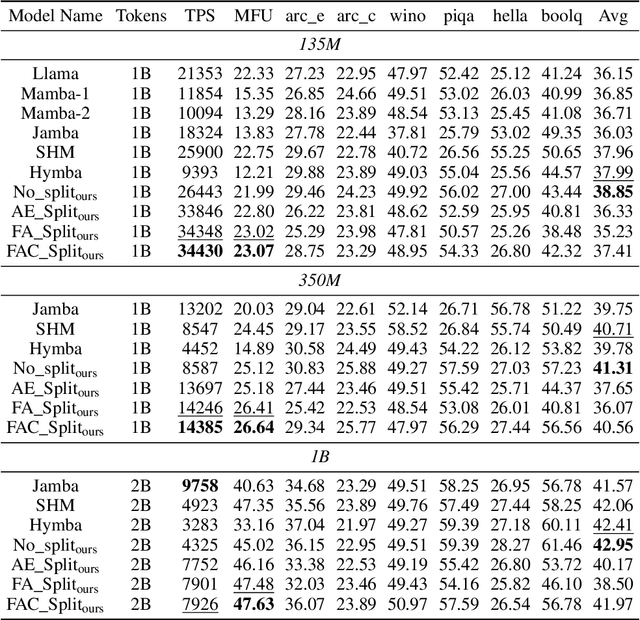
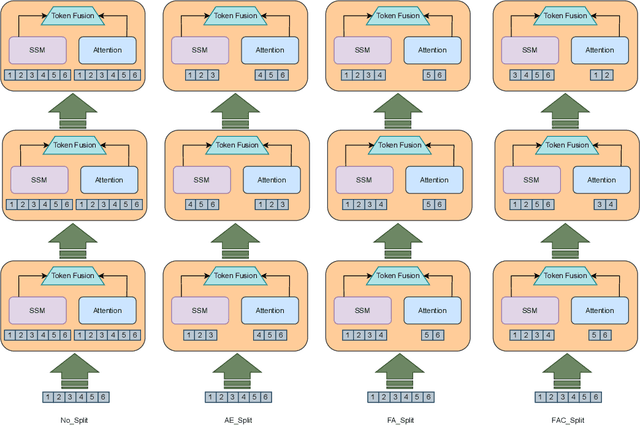
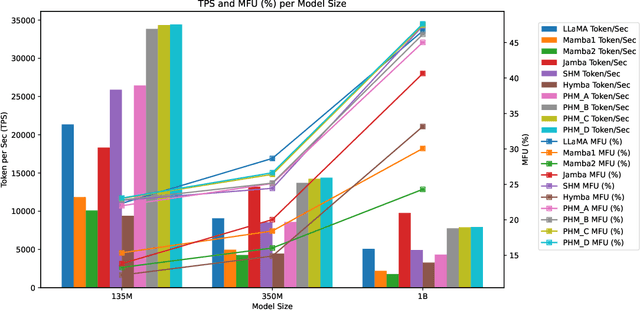
Abstract:Attention and State-Space Models (SSMs) when combined in a hybrid network in sequence or in parallel provide complementary strengths. In a hybrid sequential pipeline they alternate between applying a transformer to the input and then feeding its output into a SSM. This results in idle periods in the individual components increasing end-to-end latency and lowering throughput caps. In the parallel hybrid architecture, the transformer operates independently in parallel with the SSM, and these pairs are cascaded, with output from one pair forming the input to the next. Two issues are (i) creating an expressive knowledge representation with the inherently divergent outputs from these separate branches, and (ii) load balancing the computation between these parallel branches, while maintaining representation fidelity. In this work we present FlowHN, a novel parallel hybrid network architecture that accommodates various strategies for load balancing, achieved through appropriate distribution of input tokens between the two branches. Two innovative differentiating factors in FlowHN include a FLOP aware dynamic token split between the attention and SSM branches yielding efficient balance in compute load, and secondly, a method to fuse the highly divergent outputs from individual branches for enhancing representation expressivity. Together they enable much better token processing speeds, avoid bottlenecks, and at the same time yield significantly improved accuracy as compared to other competing works. We conduct comprehensive experiments on autoregressive language modeling for models with 135M, 350M, and 1B parameters. FlowHN outperforms sequential hybrid models and its parallel counterpart, achieving up to 4* higher Tokens per Second (TPS) and 2* better Model FLOPs Utilization (MFU).
Enhancing Learned Knowledge in LoRA Adapters Through Efficient Contrastive Decoding on Ascend NPUs
May 20, 2025Abstract:Huawei Cloud users leverage LoRA (Low-Rank Adaptation) as an efficient and scalable method to fine-tune and customize large language models (LLMs) for application-specific needs. However, tasks that require complex reasoning or deep contextual understanding are often hindered by biases or interference from the base model when using typical decoding methods like greedy or beam search. These biases can lead to generic or task-agnostic responses from the base model instead of leveraging the LoRA-specific adaptations. In this paper, we introduce Contrastive LoRA Decoding (CoLD), a novel decoding framework designed to maximize the use of task-specific knowledge in LoRA-adapted models, resulting in better downstream performance. CoLD uses contrastive decoding by scoring candidate tokens based on the divergence between the probability distributions of a LoRA-adapted expert model and the corresponding base model. This approach prioritizes tokens that better align with the LoRA's learned representations, enhancing performance for specialized tasks. While effective, a naive implementation of CoLD is computationally expensive because each decoding step requires evaluating multiple token candidates across both models. To address this, we developed an optimized kernel for Huawei's Ascend NPU. CoLD achieves up to a 5.54% increase in task accuracy while reducing end-to-end latency by 28% compared to greedy decoding. This work provides practical and efficient decoding strategies for fine-tuned LLMs in resource-constrained environments and has broad implications for applied data science in both cloud and on-premises settings.
Is AI Robust Enough for Scientific Research?
Dec 19, 2024



Abstract:We uncover a phenomenon largely overlooked by the scientific community utilizing AI: neural networks exhibit high susceptibility to minute perturbations, resulting in significant deviations in their outputs. Through an analysis of five diverse application areas -- weather forecasting, chemical energy and force calculations, fluid dynamics, quantum chromodynamics, and wireless communication -- we demonstrate that this vulnerability is a broad and general characteristic of AI systems. This revelation exposes a hidden risk in relying on neural networks for essential scientific computations, calling further studies on their reliability and security.
LLM-R: A Framework for Domain-Adaptive Maintenance Scheme Generation Combining Hierarchical Agents and RAG
Nov 07, 2024



Abstract:The increasing use of smart devices has emphasized the critical role of maintenance in production activities. Interactive Electronic Technical Manuals (IETMs) are vital tools that support the maintenance of smart equipment. However, traditional IETMs face challenges such as transitioning from Graphical User Interfaces (GUIs) to natural Language User Interfaces (LUIs) and managing complex logical relationships. Additionally, they must meet the current demands for higher intelligence. This paper proposes a Maintenance Scheme Generation Method based on Large Language Models (LLM-R). The proposed method includes several key innovations: We propose the Low Rank Adaptation-Knowledge Retention (LORA-KR) loss technology to proportionally adjust mixed maintenance data for fine-tuning the LLM. This method prevents knowledge conflicts caused by mixed data, improving the model's adaptability and reasoning ability in specific maintenance domains, Besides, Hierarchical Task-Based Agent and Instruction-level Retrieval-Augmented Generation (RAG) technologies are adopted to optimize the generation steps and mitigate the phenomenon of hallucination caused by the model's Inability to access contextual information. This enhancement improves the model's flexibility and accuracy in handling known or unknown maintenance objects and maintenance scheme scenarios. To validate the proposed method's effectiveness in maintenance tasks, a maintenance scheme dataset was constructed using objects from different fields. The experimental results show that the accuracy of the maintenance schemes generated by the proposed method reached 91.59%, indicating which improvement enhances the intelligence of maintenance schemes and introduces novel technical approaches for equipment maintenance.
DTN: Deep Multiple Task-specific Feature Interactions Network for Multi-Task Recommendation
Aug 21, 2024



Abstract:Neural-based multi-task learning (MTL) has been successfully applied to many recommendation applications. However, these MTL models (e.g., MMoE, PLE) did not consider feature interaction during the optimization, which is crucial for capturing complex high-order features and has been widely used in ranking models for real-world recommender systems. Moreover, through feature importance analysis across various tasks in MTL, we have observed an interesting divergence phenomenon that the same feature can have significantly different importance across different tasks in MTL. To address these issues, we propose Deep Multiple Task-specific Feature Interactions Network (DTN) with a novel model structure design. DTN introduces multiple diversified task-specific feature interaction methods and task-sensitive network in MTL networks, enabling the model to learn task-specific diversified feature interaction representations, which improves the efficiency of joint representation learning in a general setup. We applied DTN to our company's real-world E-commerce recommendation dataset, which consisted of over 6.3 billion samples, the results demonstrated that DTN significantly outperformed state-of-the-art MTL models. Moreover, during online evaluation of DTN in a large-scale E-commerce recommender system, we observed a 3.28% in clicks, a 3.10% increase in orders and a 2.70% increase in GMV (Gross Merchandise Value) compared to the state-of-the-art MTL models. Finally, extensive offline experiments conducted on public benchmark datasets demonstrate that DTN can be applied to various scenarios beyond recommendations, enhancing the performance of ranking models.
An Outline of Prognostics and Health Management Large Model: Concepts, Paradigms, and Challenges
Jul 01, 2024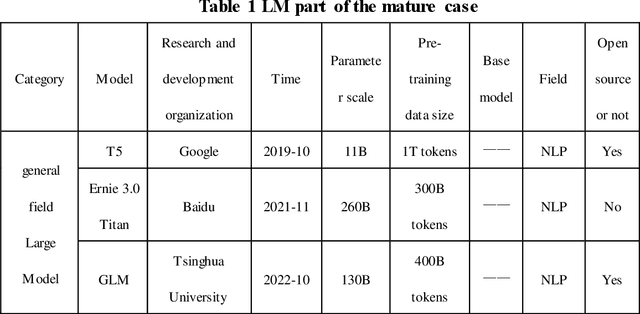
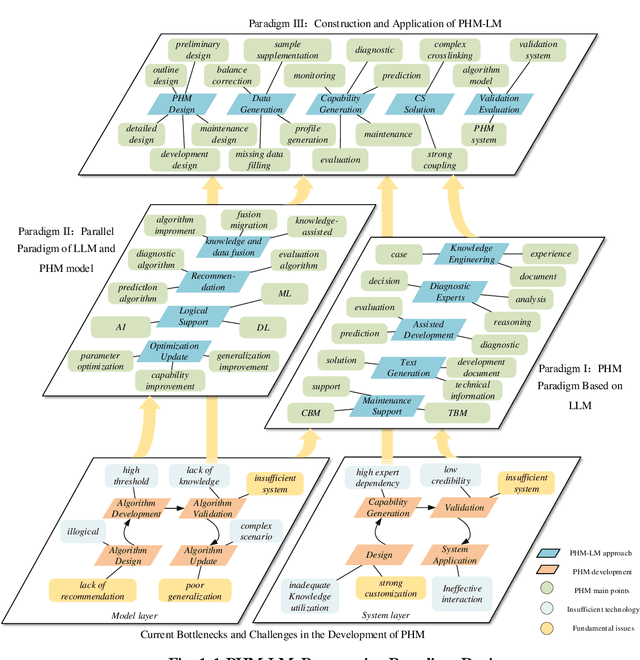
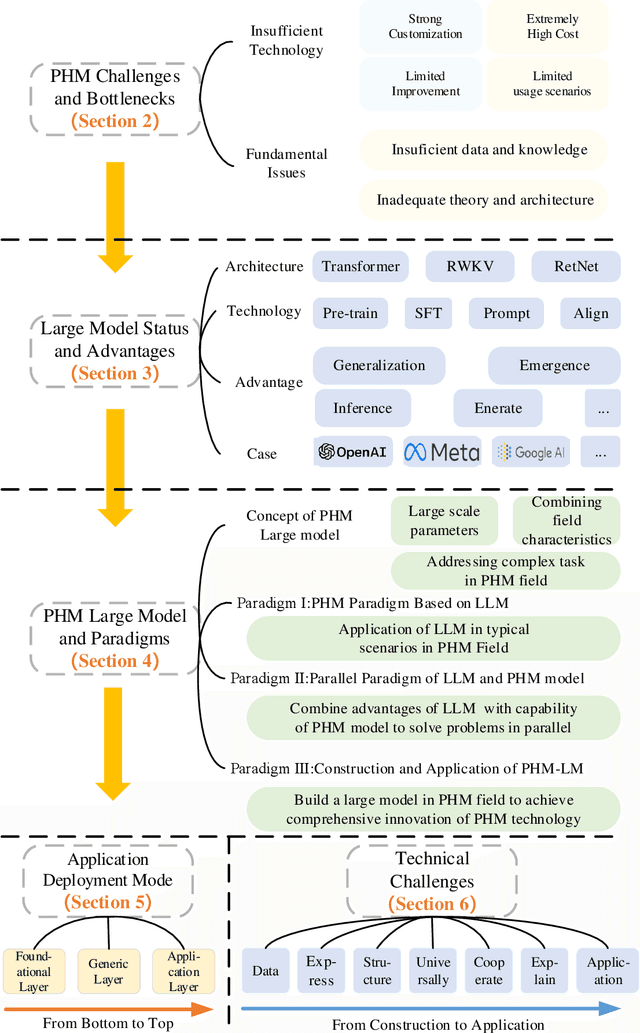
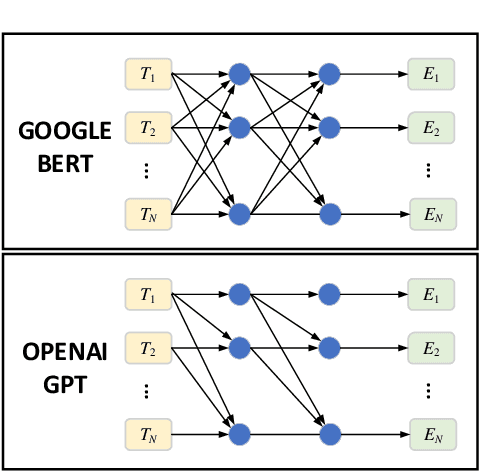
Abstract:Prognosis and Health Management (PHM), critical for ensuring task completion by complex systems and preventing unexpected failures, is widely adopted in aerospace, manufacturing, maritime, rail, energy, etc. However, PHM's development is constrained by bottlenecks like generalization, interpretation and verification abilities. Presently, generative artificial intelligence (AI), represented by Large Model, heralds a technological revolution with the potential to fundamentally reshape traditional technological fields and human production methods. Its capabilities, including strong generalization, reasoning, and generative attributes, present opportunities to address PHM's bottlenecks. To this end, based on a systematic analysis of the current challenges and bottlenecks in PHM, as well as the research status and advantages of Large Model, we propose a novel concept and three progressive paradigms of Prognosis and Health Management Large Model (PHM-LM) through the integration of the Large Model with PHM. Subsequently, we provide feasible technical approaches for PHM-LM to bolster PHM's core capabilities within the framework of the three paradigms. Moreover, to address core issues confronting PHM, we discuss a series of technical challenges of PHM-LM throughout the entire process of construction and application. This comprehensive effort offers a holistic PHM-LM technical framework, and provides avenues for new PHM technologies, methodologies, tools, platforms and applications, which also potentially innovates design, research & development, verification and application mode of PHM. And furthermore, a new generation of PHM with AI will also capably be realized, i.e., from custom to generalized, from discriminative to generative, and from theoretical conditions to practical applications.
 Add to Chrome
Add to Chrome Add to Firefox
Add to Firefox Add to Edge
Add to Edge